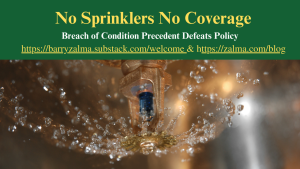No Sprinklers – No Coverage

See the full video at https://rumble.com/v3x2s1f-no-sprinklers-no-coverage.html and at https://youtu.be/IfcxiDYTx_4
Blog Post 4673
Plaintiff appealed the trial court’s order granting summary disposition in favor of defendant. In 23771 Blackstone, LLC v. Conifer Insurance Company, No. 364333, Court of Appeals of Michigan (November 16, 2023) the Plaintiff sought to avoid the fact it breached the material condition requiring it to maintain a fire sprinkler system as a protective safeguard.
FACTS
A fire occurred at plaintiff’s building in Warren, Michigan. The building housed a marijuana growing operation. Defendant insured the property against fire and other hazards under a commercial property insurance policy that defendant originally issued in 2017 and renewed annually thereafter. The parties did not dispute that defendant’s policy included a Protective Safeguards Endorsement (PSE), which provided, in pertinent part that the policy required as a condition precedent that the insured was “required to maintain the protective devices or services listed in the Schedule. The protective safeguards to which the endorsement applied was an Automatic Extinguishing System.
After the fire, plaintiff filed a claim under the policy, but defendant denied the claim because the property did not have an automatic extinguishing system (AES).
Plaintiff sued alleging that defendant had repeatedly inspected the property and “was aware, or should have been aware, from the inspection and other sources, that the property did not have an automatic sprinkler system.”
The insurer moved for summary disposition arguing that the policy language was clear and unambiguous, and that because plaintiff did not have an AES on its property, it was precluded from recovering fire protection benefits under the terms of the policy.
Plaintiff faced with an obvious failure of a condition responded that that defendant should be estopped from denying coverage for lack of an AES because the PSE was ambiguous since it did not actually define the system.
The trial court ruled that the insurer was entitled to summary disposition because the policy unambiguously precluded coverage if the insured property did not have an AES, and it was undisputed that there was no AES on plaintiff’s property.
AMBIGUITY
Initially, plaintiff argued that the language of the policy was ambiguous and that it should be construed against defendant and in favor of coverage because an AES is not defined in the PSE. Finding that the language of the PSE was not ambiguous the Court of Appeals noted that the PSE refers to a definition of an “automatic sprinkler system,” stating that it means: “a. any automatic fire protective or extinguishing system, including connected: (1) Sprinklers and discharge nozzles; (2) Ducts, pipes, valves, and fittings; (3) Tanks, their component parts and supports; and (4) Pumps and private fire protection mains. b. When supplied from an automatic fire protective system; (1) Non-automatic fire protective systems; and hydrants, standpipes, and outlets.” [Emphasis added.]
Accordingly, the court concluded that the PSE is not ambiguous because it adequately explained the meaning of an AES.
Plaintiff asserted that the AES requirement should not bar coverage for its fire loss because both it and defendant were fully aware that an AES did not exist at the property. Plaintiff was aware because it owned the property, and defendant was aware because multiple inspections revealed that there was no AES on the property.
However, the mere fact that defendant and plaintiff may have been aware that the property did not have an AES does not establish that the parties mutually understood and agreed that an AES was not required as a condition of coverage. The policy unambiguously required that the property have an AES as a condition of coverage, and there was no evidence that defendant ever intended or agreed that an AES was not necessary. There was no evidence of a mutually shared factual mistake by the parties regarding the impact of not having an AES at the property on the availability of coverage.
Insurance policies are contracts. They agree to indemnify an insured against multiple risks of loss but never every potential risk faced by the insured. When an insurer requires protective safeguards like fire sprinklers or burglar alarms it reduces its premium because of the fact that the risk of loss is lessened by the protective safeguard. Failure to maintain a protective safeguard, a condition precedent, eliminates coverage because the risk of loss was not as promised even if the loss was not by fire.
 (c) 2023 Barry Zalma & ClaimSchool, Inc.
(c) 2023 Barry Zalma & ClaimSchool, Inc.
Please tell your friends and colleagues about this blog and the videos and let them subscribe to the blog and the videos.
Subscribe to Excellence in Claims Handling at locals.com at https://zalmaoninsurance.locals.com/subscribe or at substack at https://barryzalma.substack.com/publish/post/107007808
Go to Newsbreak.com https://www.newsbreak.com/@c/1653419?s=01
Follow me on LinkedIn: www.linkedin.com/comm/mynetwork/discovery-see-all?usecase=PEOPLE_FOLLOWS&followMember=barry-zalma-esq-cfe-a6b5257
Daily articles are published at https://zalma.substack.com. Go to the podcast Zalma On Insurance at https://podcasters.spotify.com/pod/show/barry-zalma/support; Go to Barry Zalma videos at Rumble.com at https://rumble.com/c/c-262921; Go to Barry Zalma on YouTube- https://www.youtube.com/channel/UCysiZklEtxZsSF9DfC0Expg; Go to the Insurance Claims Library – http://zalma.com/blog/insurance-claims-library.
Like this:
Loading…
Related
About Barry Zalma
An insurance coverage and claims handling author, consultant and expert witness with more than 48 years of practical and court room experience.







